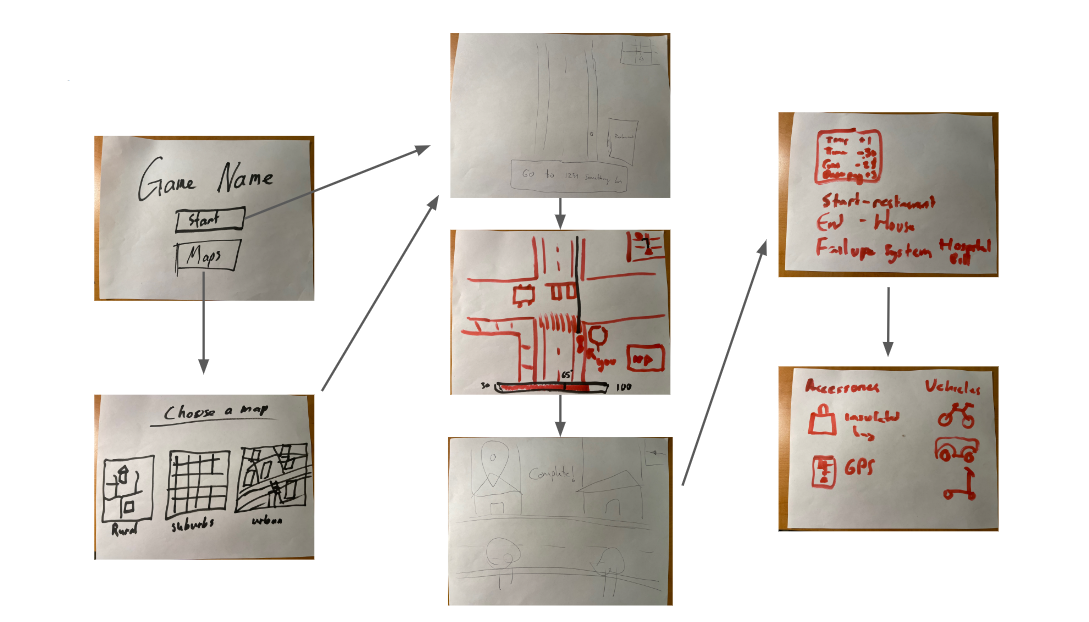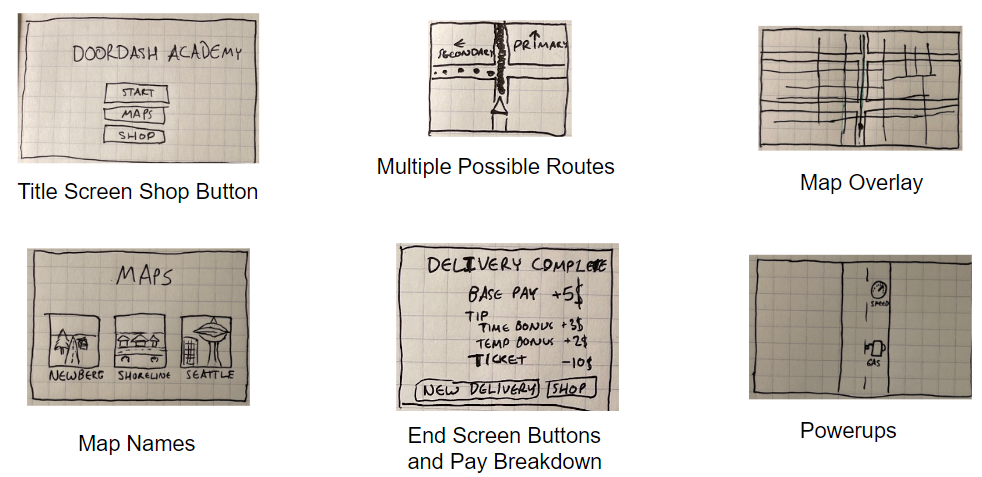Devlog: Jan-11-2023
On Tuesday, January 10th, we had our first paper prototype demonstration of our game in class. Other groups would “play” our game by interacting with our papers and we would show them how our game would respond. In writing, the event sounds a little silly, but it forced us to boil our game down to a few key features, and we received our first round of feedback before writing any game code.
 A flowchart of our paper prototype showing transitions between
various “screens” a player may encounter.
A flowchart of our paper prototype showing transitions between
various “screens” a player may encounter.
Overall, the testing session went well. While testers remarked that our UI elements could be more descriptive, they stated that the experience was intuitive, and our game idea was easy to understand. In fact, the transitions between each paper took more time to explain than any actual game rule. It was hard to demonstrate how our game required strategically planning routes across the map to achieve the best time. Throughout the demonstration, testers offered a number of possible improvements to the game and asked multiple questions that we had not considered at the time.
Improvements
The menu of playable maps should have explicit map names.
Agreed. Not much to explain here.
Minimap should emulate Google Maps.
This is a driving simulator, after all. We’re not entirely sure how feasible it is to implement this over the next few months. It may end up looking like a nondescript rectangle with some lines for roads.
There should be an in-game button to view the full map.
A must-have feature of open-world games. Should DoorDash Academy have this feature? On one hand, it would help the player navigate to their destination, but it would be more challenging to not allow them to view the map while driving. Perhaps a middle ground is to allow the player to pull up the map only if they are completely stopped and it would not pause in-game time.
There should be environmental obstacles.
Car crashes, fallen trees, slick roads. Quite the annoyance if you want to get to your destination on time. While cars and pedestrians were obvious obstacles, we hadn’t considered any of these.
There should be a shop button.
Being able to view the shop from the main (or sub-) menu, makes sense. Perhaps the player would like to choose a particular map based on the amount of money they need for an upgrade.
Power-ups?
Certainly, this is a staple of many game genres. Introducing power-ups change the mechanics of the game as the player would also maneuver to gain power-ups. More discussion is required before we make a decision on this feature.
Questions
What happens when you crash?
Two different paths here: (1) an arcade-style you-crash-you-die type of game where running into an obstacle results in a restart and loss of money, or (2) a “health” stat of some kind where you can take damage multiple times, either in the form of hearts or HP.
What happens when we speed?
Clearly, the objective of this game is speed. But good citizens should follow the traffic laws, right? Like the old GTA games, our game should have cops that are there to enforce laws, which leads to the next question…
What is the interaction with cops?
Perhaps cops, either on motorcycle or in a car, have a detection radius or cone. If a player speeds or breaks the law within that detection zone, the cop will pursue them and/or a ticket will be issued, resulting in a financial penalty that will be applied at the end of the delivery.
What happens if the temperature bar goes all the way down?
If the player refuses to make a delivery, (or just drives way too slow), the player will fail their delivery. They will certainly not earn a reward, but they may also be hit with a “not delivered” penalty.
What happens when delivering frozen food?
In the case, the temperature bar will most likely be inverted and the delivery must be made before the food gets too warm.
Most of these improvements will be incorporated into our game in the coming months. We will be presenting these findings in class tomorrow. Enjoy some more drawings of potential improvements.
 Paper prototypes of improvements based on testing feedback.
Paper prototypes of improvements based on testing feedback.